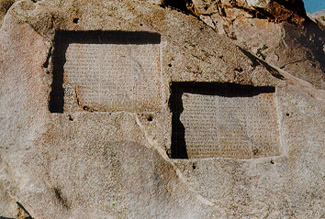

Iranian LanguagesChista; Political, Social, Scientific, Literary & Artistic (Monthly) Oct 2000, No. 171 By: Dr. Suzan Kaviri Pages: 26 - 27  Summary: Iranian languages are applied to a group of inter-related languages which only from linguistic point of view, share common characteristics, and not in terms of geographical and political borders. In the ancient period, Iranian languages encompassed a
broad geographical area: From the Caucasus in the
North-West (Assi language) to the Persian Gulf (Baluchi
language), to Mosandom Peninsula in the Gulf of Oman
(The Kumzari language); from the North of the
Euphrates in the West (Kurdish language - Zaza) to the Hindokesh and Pamir in the East
(Serikuli language).
Persian dialects which are in use outside of Iran's current geographical borders are as
follows:
Assi, Tajiki, Pashtu, Yaghnabi, Serikoli, Komzari, Kurdish, and Tati.
Text: The term "Iran" is derived from three separate words throughout the
history of the Farsi
language: From the middle Farsi word `Eran'; from the ancient Farsi word `Ariya', and from the
Avesta Farsi word `Airya', which itself is derived from the ancient Persian word `Arya'.
The term `Arya` was a designation for all the Aryan and Indo-Iranian tribes. The term comes from the Avesta adjective `Aryana' and means a person who hails from the land of Arya. The term `Iran', meaning `the land of Aryans', is derived from the plural of the word
`Aryana',
that is `Aryanam' in Avesta. During the middle Farsi language, `Aryanam' was modified to `Eran
Shar'. In Avesta, `Aryanam' was also the origin of the term `Iran Vij' (Aryanam Vaejah), meaning
`the Iranian Race and Origin'. In the Parthian dialect, the term has been changed to `Aryan'. In
the Pahlavi dialect, `er', `Aryan', `Eran-Sahr' and `Eran-Vej' are all different variations of the
same term.
In terms of etymology ,`er' means `noble' and `warrior', and when used with the (relation) suffix `an', it means; `the noble race', `worriers", and `Aryans'. However the suffix `an' can also change the meaning of the term to mean `the Iranian Land' when used as a place suffix. The term `Arya' is derived from the verb `ar', meaning `to move'. When used with the middle
letter "i" and the (noun) suffix `ya', it means `Iranian' or `Aryai'.
The following is a list of names in Avesta derived from the term `Iran':
Airyana (Adjective) = Aryan
IRANIAN LANGUAGE
Iranian languages are applied to a group of inter-related languages which only from linguistic
point of view, share common characteristics, and not in terms of geographical and political
borders. In totality these languages along with the Indo-Aryan languages, the Indo-Aryan or
Indo-Iranian branches, encompass the extended family of Indian and European languages.
In the ancient period, Iranian languages encompassed a broad geographical area: From the
Caucasus in the North-West (Assi language) to the Persian Gulf (Baluchi language), to
Mosandom Peninsula in the Gulf of Oman (The Kumzari language); from the North of the
Euphrates in the West (Kurdish language - Zaza) to the Hindokesh and Pamir in the East
(Serikuli language).
Prior to the migration of the Turkish tribes to the Eastern regions, the Iranian languages
covered
even a greater geographical area, extending westward to the northern and western shores of the
Black Sea where they spoke the Sakaee language, and stretching to the north as far as the
northern Mongolia and the Chinese border, where the Soghdi language was spoken.
Persian dialects which are in use outside of Iran's current geographical borders are as
follows:
Assi: in the Northern Caucasus (sequel of the Khotani or Sakaee or Eskiti dialect)
The Turkish and Arabic languages spoken in parts of Iran today, have no relationship with
the
Persian languages.
|